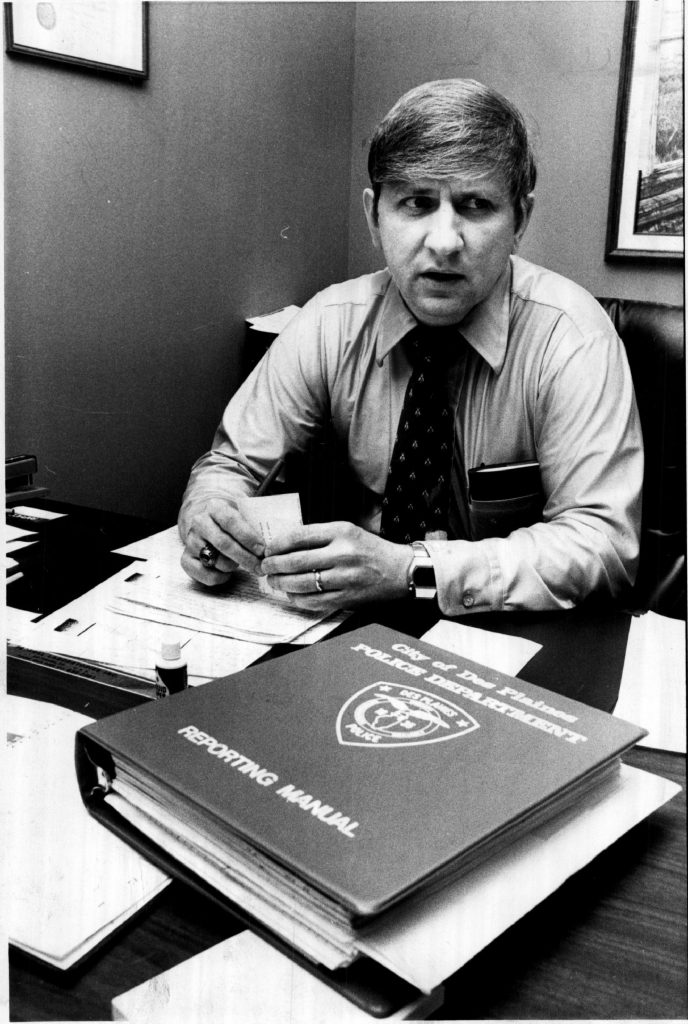Winner of the Fall 2017 StMU History Media Award for
Article with the Best Introduction
It was December 12, 1978. Just as every morning, Chief Detective Joseph Kozenczak sat in his office on the first floor and went over the reports from the past 24 hours. Sipping some coffee, he started off by reading through Monday’s list of events: “a domestic argument which ended with the police restoring peace, a break-in on Phoenix Drive, a report of an abandoned vehicle, several malfunctioning alarms in businesses requiring police assistance to restore, etc.”1 It wasn’t until midway through the list of Monday’s Report when Joseph Kozenczak came across the name Robert Jerome Piest, a missing persons report filed by his mother Elizabeth Piest.2

Joseph Kozenczak had found this to be very interesting because of the narrative part of the report. As described from the report, the mother and son had a very repetitive routine. Elizabeth would pick up her son at 5:30 p.m. after his gymnastics session at Maine West High School in Des Plaines, Illinois. Then she would have his dinner and milk to eat in the car, and he’d usually eat it as Elizabeth drove to Nisson Pharmacy, where Robert worked. But Monday was a bit different. Rob ate a sandwich. Elizabeth had saved her birthday cake to be cut after picking up Rob from work. She arrived at Nisson Pharmacy at 9 p.m., and she went in to get Rob. Rob asked his mother to wait outside so he could discuss a summer job with a construction contractor. Twenty minutes passed and Elizabeth went to check the parking lot only to find that she was alone. There was no sign of Rob, or this mysterious construction contractor. Not knowing who the contractor was, Elizabeth called her son’s friends and one of the owners of the pharmacy, and found out that his name was John Wayne Gacy, Jr.3
Something about the report didn’t seem right to Detective Kozenczak. He knew Robert had no reason to leave his family, or run away from home, so where was he? He read the report one more time. While reading through the report, Detective Kozenczak found that the young boy Robert was born the same year as his own son, as well as the fact that the two boys attended the same high school (Maine West High School).
Detective Kozenczak decided to put “Ronnie” Ron Adams to investigate the Piest missing persons case. He chose Adams because he wasn’t just a good cop, but he also had passion for his job. He knew Adams was the right one for this case. Also Kozenczak knew about the fact that Adams had a family, and had hoped it would make things more personal while continuing the harsh investigation. Adams didn’t waste any time at all. He talked with the two brothers who owned the pharmacy, and found out that the contractor, John Gacy, had been in the store not once, but twice. To check Gacy’s alibi, Adams then called Gacy at 9:15 a.m. and Gacy explained that he had been present at the pharmacy, but only because of some remodeling plans, and to gather or see if there were any tools he needed. He also said, “He had not spoken, nor had any personal contact with the missing boy.” It was at this point that things started to not add up in the mind of Detective Kozenczak.4

The investigation “wasn’t getting anywhere fast” as Kozenczak put it. It was not until Detective Jim Pickell stepped out of his office, when things started to take off. The two detectives knew about Gacy’s arrest, but did not know exactly what John Wayne Gacy had been arrested for. Pickell went off in search of what Gacy had been arrested for. Pickell was known to get what he wanted, and always did what he had to in order to obtain it.
The two Detectives then read Gacy’s rap sheet, which was filled with numerous crimes, the first and most important: “20 May 1968-Waterloo, Iowa-Sodomy-10 years.” The word “sodomy” stuck into the two detectives’ heads. After going through the rap sheet, the two detectives were both convinced Gacy was deeply involved in the disappearance of Robert Piest.5 Later that day,Detectives Kozenczak, Pickell, Olsen, and Sommerschield went to Gacy’s house to interview him. Kozenczak and Pickell went inside, while Sommerschield and Olsen waited outside on the street. While inside the house, Gacy sat in his recliner, and not much happened except for the same story he gave Adams over the phone. Kozenczak had coaxed Gacy into coming down to the station, and after a few attempts, it finally worked.
Gacy called and came in around noon. He had no problem telling the same story, as well as filling out the witness report; but he did seem agitated after he refused a lie detector test. While that was going on, Kozenczak was gathering his warrant, and on his way back to get Gacy’s keys. At 5 p.m. Kozenczak rushed in to find Gacy and asked for his keys. Gacy was terrified and filled with anger. He fought and argued before he was forced to give up his keys.
As Kozenczak put it, “I put the key in the door and I felt like I was stepping into the unknown.”6 They searched the house and found a crawl space that was creepy, but nothing seriously incriminating; but they did take many things as evidence. They took clothes, papers, towels, shoes, etc. It was not until the third warrant was issued that Detective Kozenczak decided to crawl into the crawl space. That’s when everything changed in the blink of an eye.
When Detective Kozenczak crawled into the muddy crawl space, he was face to face with not one or two, but three bodies. He encountered the three bodies in the first ten minutes he had spent in the crawl space. A call was made, and as soon as the news was told to Gacy about the findings, he admitted to the murders with no hesitation. Once the crime scene was investigated and dug up, and everything was done, the Medical Examiner was called in, and over the course of a few weeks or so, twenty-four more bodies were discovered in the ground beneath Gacy’s crawl space. As reported by Detective Kozenczak, “There was plastic over their heads and most of them were partially clothed. They had been strangled and were in various stages of decomposition. There were skeletons everywhere.”7 But that wasn’t the end of finding bodies. The serial killer admitted that there was not enough room left for his last six victims. With no room left for the bodies, Gacy had turned to the river, dumping his last victim Robert Piest into the Des Plaines river. The river was near the Chicago Airport. Gacy admited to dumping the body in the winter of 1978, although they found his body in late spring of 1979. Robert’s body had froze, and was conserved in ice until it thawed out late spring.

Justice was finally served when Gacy was arrested and found guilty after a long and devastating trial in March 13, 1980. He received multiple sentences. “The jury quickly returned a verdict of guilty on thirty-three counts of murder, twelve carrying a death sentence, and two charges of sexual assault.” The jury did the right thing by putting a heartless monster like Gacy away. Gacy was executed by lethal injection on May 10, 1994, in the Stateville Correctional Center in Joliet, Illinois. Gacy was pronounced dead at 12:58 a.m.8
The ending somehow did not seem to lift the weight off the shoulders of Detective Joseph R. Kozenczak, as he stated “I thought that I would feel that it was all resolved then. But it wasn’t. It was just hard to live with.”9 Someone will never understand what it was like to be in the chase, but we know how hard and personal it was for Detective Joseph R. Kozenczak. After the chase was done and finally put to rest, Kozenczak retired and went on to write his own book, A Chicago Killer, which was a great insight into what the Gacy Case was like. Unfortunately Joseph R. Kozenczak passed away Wednesday May 13, 2015. He had served on the Des Plaines Police team as Chief Detective for 27 years.10 Detective Joseph R. Kozenczak’s passion, strength, and patience will live on longer than we can imagine. He brought justice to 33+ families and their relatives.
- Joseph R. Kozenczak and Karen M. Kozencz, The Chicago Killer: The Hunt For John Wayne Gacy (Xlibris, Corp., 2011), 23. ↵
- Joseph R. Kozenczak and Karen M. Kozencz, The Chicago Killer: The Hunt For John Wayne Gacy (Xlibris, Corp., 2011), 24. ↵
- Joseph R. Kozenczak and Karen M. Kozencz, The Chicago Killer: The Hunt For John Wayne Gacy (Xlibris, Corp., 2011), 25. ↵
- Joseph R. Kozenczak and Karen M. Kozencz, The Chicago Killer: The Hunt For John Wayne Gacy (Xlibris, Corp., 2011), 28. ↵
- Joseph R. Kozenczak and Karen M. Kozencz, The Chicago Killer: The Hunt For John Wayne Gacy (Xlibris, Corp., 2011), 37. ↵
- Joseph R. Kozenczak and Karen M. Kozencz, The Chicago Killer: The Hunt For John Wayne Gacy (Xlibris, Corp., 2011), 58. ↵
- Ginnie Teo, “Sleuth Recalls Viciousness of Killer,” The Straits Times (Singapore, August 1997). ↵
- Debbie Howlett and Sandra Sanchez, “John Wayne Gacy Executed/ Fatal Injection Ends Saga Of Serial Killer,” USA Today, (May 1994): 3. ↵
- Ginnie Teo, “Sleuth Recalls Viciousness of Killer,” The Straits Times (Singapore, August 1997). ↵
- N. Sameer Yacoub, “Detective who led John Wayne Gacy Investigation Dies,” US News Online, May 15, 2015. ↵



117 comments
Shea Slusser
I have never heard of Gacy or of his crimes, but apparently he has made a big impact in the history of serial killers. I was a little confused with the pictures of him in the clown suites because it was never really mentioned in the article from my understanding, but now a days it seems like we have to be so careful with our children and even with ourselves in our everyday lives due to the amount of evil that roams Americas streets everyday.
Nicholas Hatch
The story of John Wayne Gacy was very told, making this a very good article. It was very eerie reading about how Detective Kozenczak was searching Gacy’s property and found three dead bodies in his crawl space and over the investigation found 3o more dead bodies. I like how this article was very detailed explaining the mother and son’s daily routine and how Detective Kozenczak knew something was up because the daily routine had been off. It’s disgusting that someone would commit these acts on innocent people. Overall great article with a great introduction.
Amelia Hew
This story is fascinating but terrifying at the same time to know that John Wayne Gacy was able to get away with murder for so many years. What makes it more chilling is that he’s usually dressed up as a clown that was meant to bring joy for children, however under that costume, he’s a serial killer with no remorse of human lives. Now that totally portraited the clown into a symbol for psychotic killer. Thanks to Detective Kozenczak, the victims and their family member were finally able to be brought to justice.
Kathryn Martinez
What is super interesting is that Gacy took up painting, with a lot of his artwork featuring clowns, and he would portray himself as the clown Pogo. Many of the paintings had been sold at different auctions. Twenty-five of the killer’s paintings were burned in a community bonfire in June 1994, attended by 3,000 people, including some of Gacy’s victims ‘ family members. The fact that people were willing to pay up to $20,000 for a painting, made by a serial killer is insane to me. I hope that the families of the people whose lives were taken can find peace.
Saira Locke
This article is very well put together and I love the detail put into it. I hope to one day become a homicide detective and I believe that personal connection with cases is very important. That connection that Ron Adams and Joseph Kozenczak had with the victim was very important because it gave him an extra boost of determination to solve this case. I can’t believe that Gacy lived in a home where he buried 33 bodies. He deserved the punishment that he received.
Eric Ortega Rodriguez
This is the first time that I hear about John Wayne Gacy and let me just say that I am very happy I found this article. It was bizarre to me that he had bodies in his crawl space and yet was able to remain so calm when being interrogated. Overall, this was a great article and congratulations on being an award winner for the best introduction. Very good work.
Averie Mendez
This story was chilling and you did a very good job at telling it. I’ve heard of John Wayne Gacy before but never knew the specific details about his case. It’s creepy and somewhat unsettling how people-friendly he appeared to be when he was actually a pedophile serial killer. I wonder how heartbroken his family must have been when they found out.
Mia Morales
The story of John Wayne Gacy is very chilling; it is intriguing how the people that are easily confinable in are those that are capable of some of the most horrific instances. Gacy was seen as a model citizen and someone that his neighbors can trust. It is so sad to read about how many people he killed and how honest he was about detailing.
Bianca-Rhae Jacquez
John Wayne Gacy is one of the scariest serial killers ever because he was the picture of the perfect neighbor. He was the man you would trust with your children and that’s what makes it even scarier what he did. He was the neighborhood clown and clowns are scary regardless but he gave a new name to scary clowns for every kid ever.
Danniella Villarreal
This article was very interesting to read. I don’t understand how someone could be so calm when being asked a question knowing they have dead people in a crawl space. What he did to those people was horrible and he deserves the worst they could possibly give him. I am thankful that he finally after a while got caught, and there was some relief that he was no longer going to harm anyone else.